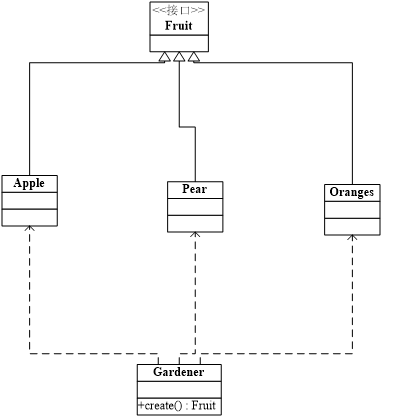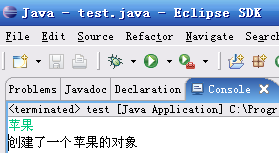第十二周上机练习
1、设计四个类,分别是:(知识点:抽象类及抽象方法)
(1)Shape表示图形类,有面积属性area、周长属性per,颜色属性color,有两个构造方法(一个是默认的、一个是为颜色赋值的),还有3个抽象方法,分别是:getArea计算面积、getPer计算周长、showAll输出所有信息,还有一个求颜色的方法getColor。
(2)2个子类:
1)Rectangle表示矩形类,增加两个属性,Width表示长度、height表示宽度,重写getPer、getArea和showAll三个方法,另外又增加一个构造方法(一个是默认的、一个是为高度、宽度、颜色赋值的)。
2)Circle表示圆类,增加1个属性,radius表示半径,重写getPer、getArea和showAll三个方法,另外又增加两个构造方法(为半径、颜色赋值的)。
(3)一个测试类PolyDemo,在main方法中,声明创建每个子类的对象,并调用2个子类的showAll方法。
package lqh; public abstract class Shape { protected double area; protected double per; protected String color; public Shape() { } public Shape(String color) { this.color = color; } public abstract void getArea(); public abstract void getPer(); public abstract void showAll(); }
package lqh; public class Rectangle extends Shape { double width; double height; public Rectangle() { } public Rectangle(double width, double height, String color) { super(); this.width = width; this.height = height; this.color = color; } public void getArea() { area = width * height; } public void getPer() { per = (width + height) * 2; } public void showAll() { System.out.println("矩形面积为:" + area + ",周长为:" + per+",颜色:"+color); } }
package lqh; public class Circle extends Shape { double radius; public Circle() { } public Circle(double radius, String color) { this.color = color; this.radius = radius; } public void getArea() { area = radius * radius * 3.14; } public void getPer() { per = 2 * radius * 3.14; } public void showAll() { System.out.println("圆的面积为:" + area + ",周长为:" + per+",颜色:"+color); } }
package lqh; public class PolyDemo { public static void main(String[] args) { // TODO Auto-generated method stub Shape c = new Circle(5,"black"); Shape r = new Rectangle(4,7,"blue"); c.getArea(); c.getPer(); c.showAll(); r.getArea(); r.getPer(); r.showAll(); } }

2、Cola公司的雇员分为以下若干类:(知识点:多态)
(1) ColaEmployee :这是所有员工总的父类,属性:员工的姓名,员工的生日月份。方法:getSalary(int month) 根据参数月份来确定工资,如果该月员工过生日,则公司会额外奖励100 元。
(2) SalariedEmployee : ColaEmployee 的子类,拿固定工资的员工。 属性:月薪
(3) HourlyEmployee :ColaEmployee 的子类,按小时拿工资的员工,每月工作超出160 小时的部分按照1.5 倍工资发放。 属性:每小时的工资、每月工作的小时数
(4) SalesEmployee :ColaEmployee 的子类,销售人员,工资由月销售额和提成率决定。 属性:月销售额、提成率
(5) 定义一个类Company,在该类中写一个方法,调用该方法可以打印出某月某个员工的工资数额,写一个测试类TestCompany,在main方法,把若干各种类型的员工放在一个ColaEmployee 数组里,并单元出数组中每个员工当月的工资。
package lqh; public class ColaEmployee { String name; int month; public ColaEmployee() { } public ColaEmployee(String name,int month){ this.name=name; this.month=month; } public double getSalary(int month) { return 0; } }
package lqh; public class SalariedEmployee extends ColaEmployee{ double monSalary; public SalariedEmployee(String name,int month,double monSalary) { super(name,month); this.monSalary=monSalary; } public double getSalary(int month) { if (super.month==month) { return monSalary +100; }else { return monSalary; } } }
package lqh; public class HourlyEmployee extends ColaEmployee{ private int hourSalary; private int hourNum; public HourlyEmployee(String name, int month,int hourSalary,int hourNum) { super(name,month); this.hourSalary=hourSalary; this.hourNum=hourNum; } public double getSalary(int month) { if(super.month==month) { if (hourNum>160) { return hourSalary*160+hourSalary*(hourNum-160)*1.5+100; }else { return hourSalary*hourNum+100; } }else { if (hourNum>160) { return hourSalary*160+hourSalary*(hourNum-160)*1.5; }else { return hourSalary*hourNum; } } } }
package lqh; public class SalesEmployee extends ColaEmployee { private int monthSales; private double royaltyRate; public SalesEmployee(String name, int month,int monthSales,double royaltyRate) { super(name, month); this.monthSales = monthSales; this.royaltyRate = royaltyRate; } public double getSalary(int month) { if(super.month == month) { return monthSales * royaltyRate + 100; }else { return monthSales * royaltyRate; } } }
package lqh; public class Company { public void getSalary(ColaEmployee c,int month) { System.out.println(c.name + "在" + month + "月的月薪为" + c.getSalary(month)+"元"); } }
package lqh; public class TestCompany { public static void main(String[] args) { // TODO Auto-generated method stub ColaEmployee[] cel = { new SalariedEmployee("拿固定工资的员工", 6, 50000), new HourlyEmployee("按小时拿工资的员工", 5, 100, 400), new SalesEmployee("销售人员", 3, 200000, 0.4) }; for (int i = 0; i < cel.length; i++) { new Company().getSalary(cel[i],6); } } }

3、利用接口实现动态的创建对象:(知识点:接口 )
(1)创建4个类
1苹果
2香蕉
3葡萄
4园丁
(2)在三种水果的构造方法中打印一句话.
以苹果类为例
class apple
{
public apple()
{
System.out.println(“创建了一个苹果类的对象”);
}
}
(3)类图如下:

(4)要求从控制台输入一个字符串,根据字符串的值来判断创建三种水果中哪个类的对象。
运行结果如图:

package lqh; public interface Yuanding { void apple(); void banana(); void putao(); }
package lqh; public class Apple implements Yuanding { public void apple() { // TODO Auto-generated method stub System.out.println("创建了一个苹果类的对象"); } public void banana() { } public void putao() { } }
package lqh; public class Banana implements Yuanding{ public void banana() { // TODO Auto-generated method stub System.out.println("创建了一个香蕉类的对象"); } public void apple() { } public void putao() { } }
package lqh; public class Putao implements Yuanding{ public void putao() { // TODO Auto-generated method stub System.out.println("创建了一个葡萄类的对象"); } public void banana() { } public void apple() { } }
package lqh; import java.util.*; public class Test { public static void main(String[] args) { // TODO Auto-generated method stub Scanner input=new Scanner(System.in); System.out.println("请输入您要创建的类:"); String a=input.nextLine(); if(a.equals("apple")) { Yuanding yuanding=new Apple(); yuanding.apple(); } else if(a.equals("banana")) { Yuanding yuanding=new Banana(); yuanding.banana(); } else if(a.equals("putao")) { Yuanding yuanding=new Putao(); yuanding.putao(); } else System.out.println("输入有误!"); } }




